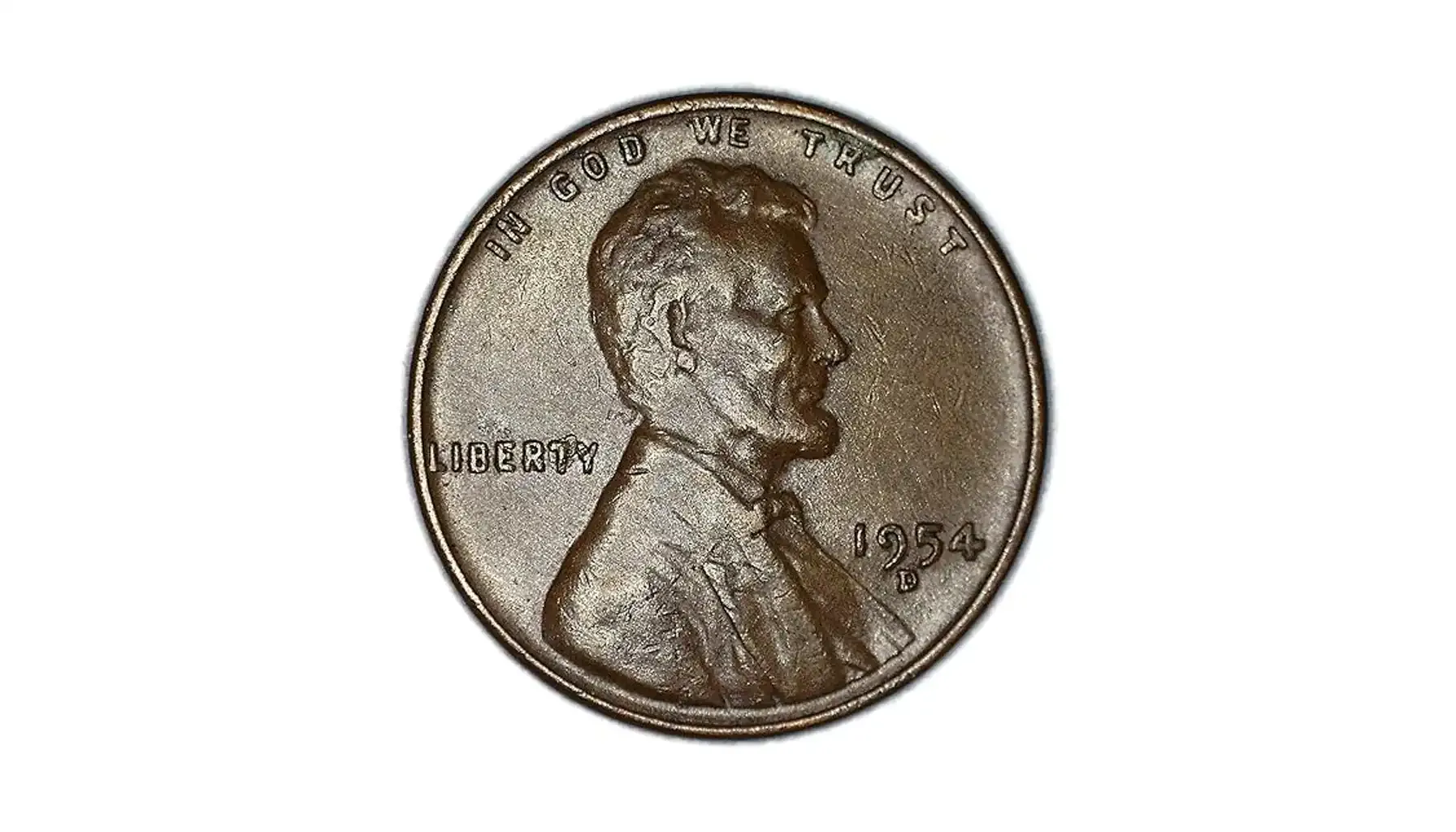Contents:
For many, the discovery of an old coin prompts the immediate question "what is a 1944 nickel worth?" This guide provides a detailed guide to understanding the value of ancient money, including special considerations for the 1944 nickel no mint mark variety and other distinct issues.
Key Considerations for Coin Value:
Rarity: This is often the primary driver of a coin's worth. It refers to how few coins were originally produced (low mintage) and, more importantly, how few have survived over time. Coins with lower existing populations are naturally more desirable to collectors.
Condition: After rarity, the coin's condition is paramount. This is formally assessed through a grading system (e.g., Good, Fine, Very Fine, About Uncirculated, Mint State). A coin's wear, presence of original luster, and absence of damage (scratches, dents, cleaning) dramatically impact its value. Even a slight difference in grade can mean a significant price change.
Mint Mark: Different mints often had varying production numbers in a given year, making coins from one mint scarcer and potentially more valuable than those from another.
Errors: These are accidental imperfections that occurred during the minting process. Common types include doubled dies (where the design appears doubled), off-center strikes (where the design is not centered on the coin blank), and die breaks (cracks or chips on the die that show up as raised lines or blobs on the coin). Such anomalies can make an otherwise common coin highly valuable to error collectors.
To accurately assess your coin, including identifying specific mint marks or potential errors, an AI-powered coin identifier app offers a practical solution, providing rapid analysis and current valuation information.
1944 Jefferson Nickel Philadelphia
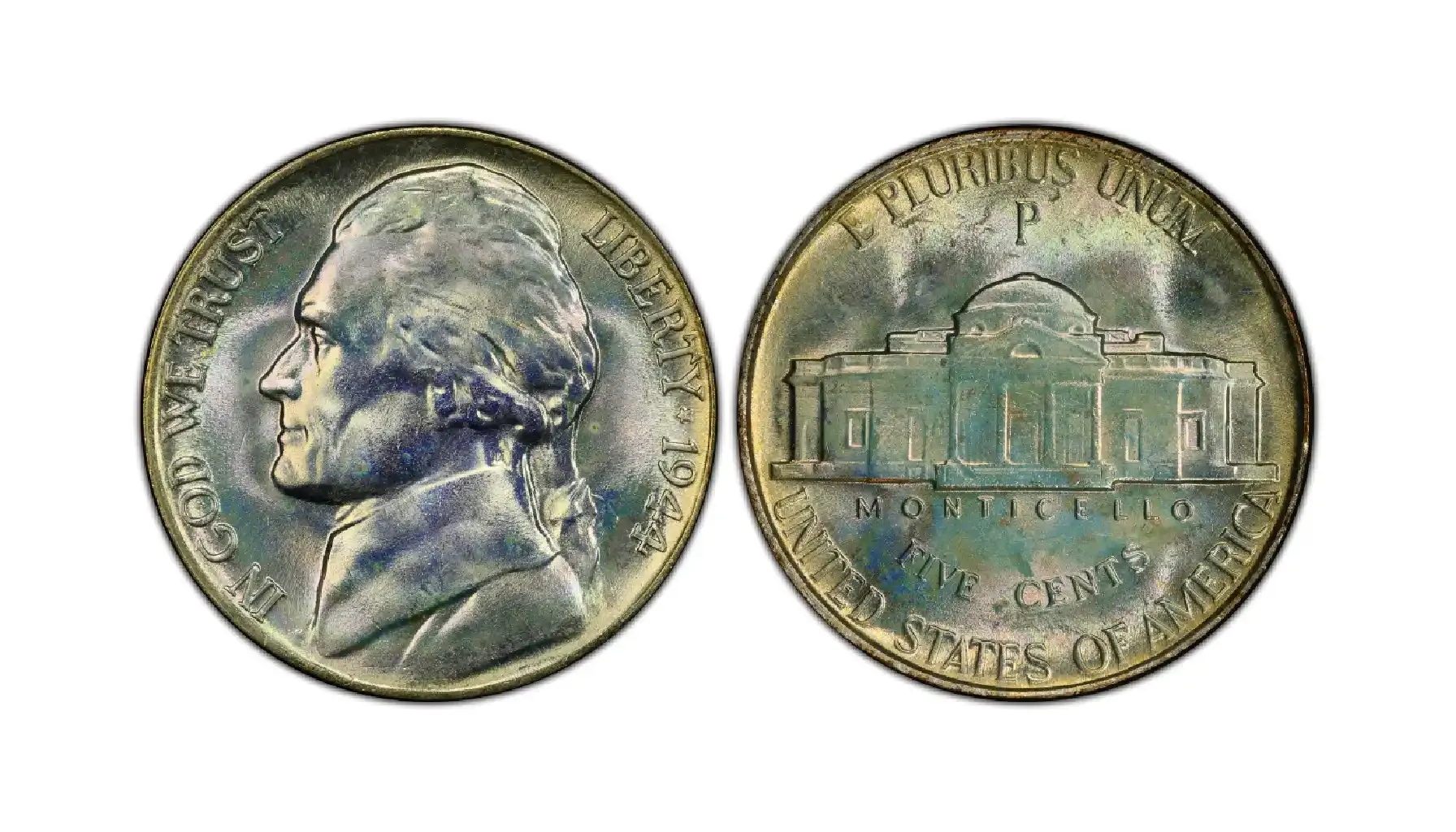
Name | 1944 Jefferson Nickel No Mint Mark |
Special Features | Features the profile of Thomas Jefferson on the obverse and Monticello on the reverse. Identified by a large "P" mint mark above Monticello, denoting its wartime silver composition. |
Mintage | 119,150,000 |
Price | $1.50 - $25 (depending on condition) |
Listed prices are approximate and may vary depending on the coin's condition, market demand, and other factors
Market Value
Grade | Price (USD) |
Circulated (G-4 to AU-58) | $1.50 - $5 |
Uncirculated (MS-60 to MS-66) | $10 - $25 |
Uncirculated (MS-67~) | $340 - $7,475 (Auction Record) |
Historical Context
The 1944 nickel P value is often a starting point for collectors interested in these wartime coins. The 1944 Jefferson Nickel from the Philadelphia Mint, distinguished by having no mint mark on the reverse (though it does have a "P" for wartime issues), saw a substantial mintage of over 119 million pieces. The coin that caused such a stir among collectors is a 1944 nickel silver five-cent piece, notable because it contains 35% silver, a wartime alteration to the typical nickel composition.
The inclusion of the 1944 nickel P above Monticello was a significant deviation from prior practice, making these coins easily distinguishable and historically noteworthy. For those wondering, how much is a 1944 P nickel worth which common in lower grades, well-preserved examples can command higher prices, particularly those with strong strikes and original luster. Many search for the 1944 P nickel value today to assess their current worth.
1944 Jefferson Nickel Denver Mint
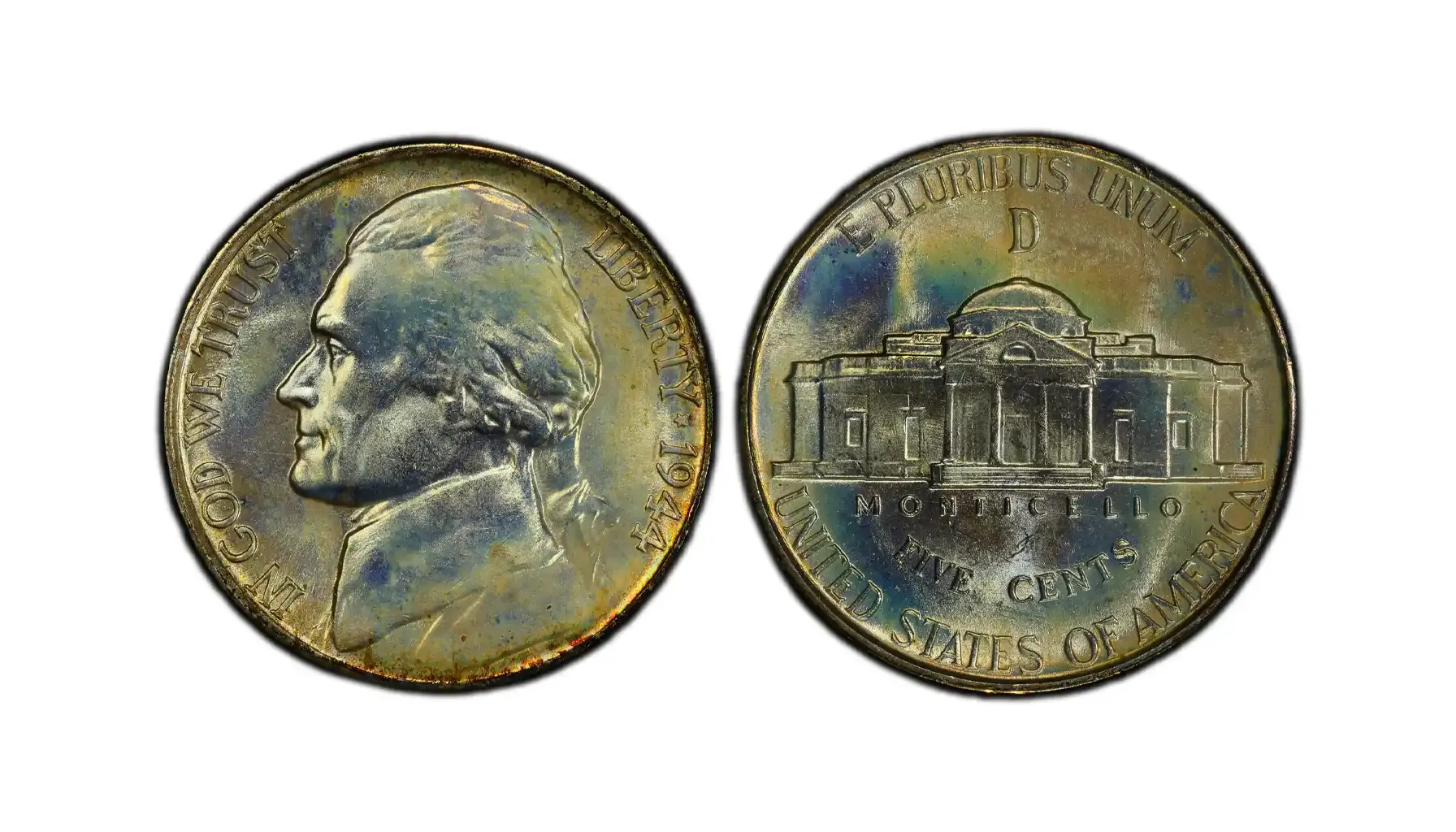
Name | 1944 Jefferson Nickel D |
Special Features | Struck at the Denver Mint with a large "D" mint mark above Monticello, indicating its silver content. |
Mintage | 32,309,000 |
Price | $1.50 - $215 (depending on condition) |
Listed prices are approximate and may vary depending on the coin's condition, market demand, and other factors
Market Value
Grade | Price (USD) |
Circulated (G-4 to AU-58) | $1.50 - $4 |
Uncirculated (MS-60 to MS-66) | $6 - $215 |
Uncirculated (MS-68 FS) | Up to $22,325 (Auction Record) |
Historical Context
The Denver Mint produced over 32 million 1944-D Jefferson Nickels, also part of the wartime silver composition. These coins played a vital role in supporting the home front economy during World War II. When considering the 1944 D Nickel value, despite their relatively high mintage, finding high-grade examples with "Full Steps" (clear details on Monticello's steps) can be challenging due to production demands and widespread circulation during a tumultuous period. Collectors often seek these 5-cents coins well-struck examples to complete their sets, making their 1944 Nickel D value higher.
1944 Jefferson Nickel San Francisco Mint
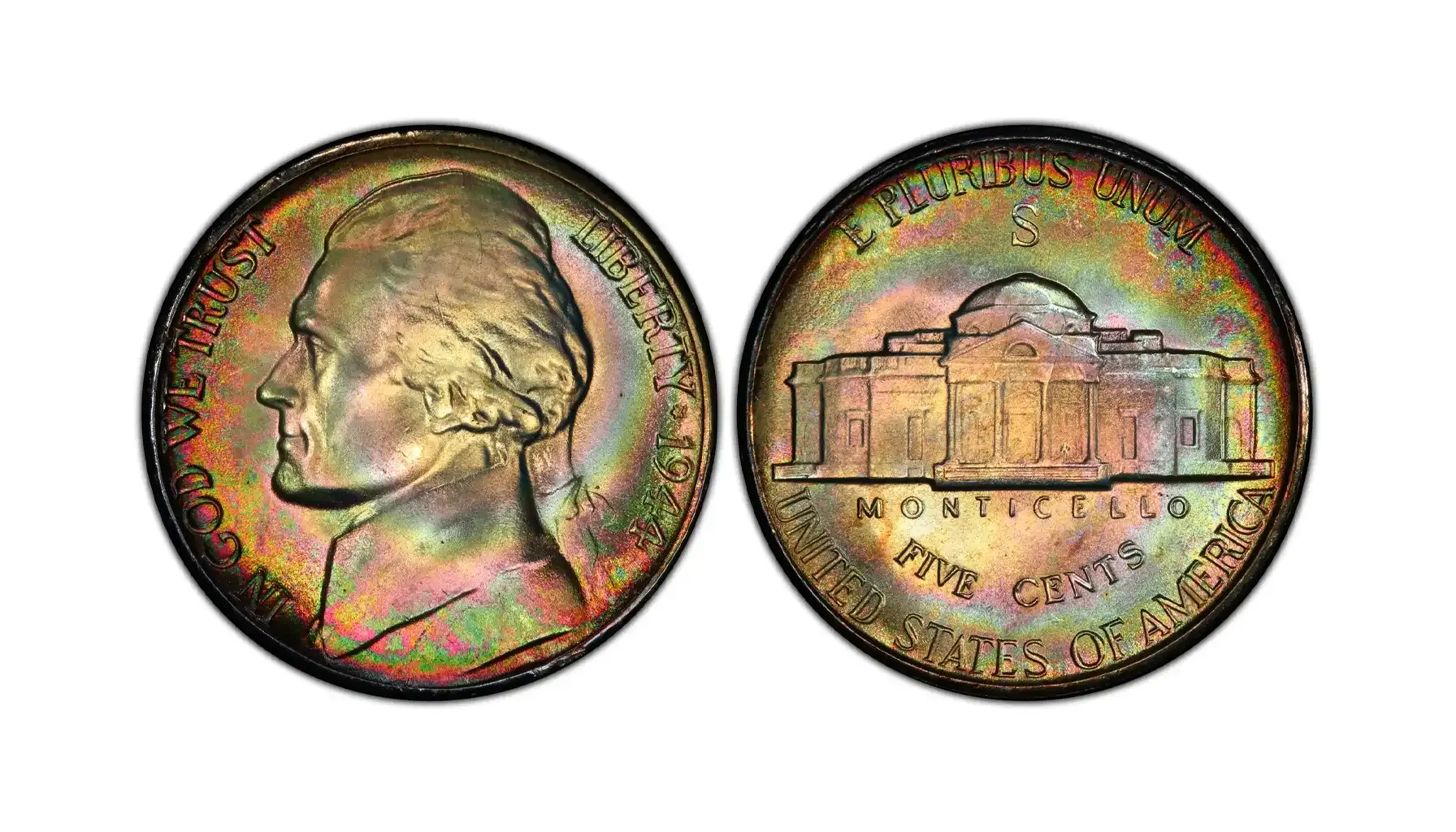
Name | 1944 Jefferson Nickel S |
Special Features | Struck at the San Francisco Mint with a large "S" mint mark above Monticello, confirming its wartime silver alloy. |
Mintage | 21,640,000 |
Price | $1.50 - $750 (depending on condition) |
Listed prices are approximate and may vary depending on the coin's condition, market demand, and other factors
Market Value
Grade | Price (USD) |
Circulated (G-4 to AU-58) | $1.50 - $4 |
Uncirculated (MS-60 to MS-66) | $6 - $450 |
Uncirculated (MS-67 FS) | $750 |
Uncirculated (MS-68 FS) | Up to $14,100 (Auction Record) |
Historical Context
With the lowest mintage among the three mints in 1944, the San Francisco Mint produced just over 21 million Jefferson Nickels. Like their Philadelphia and Denver counterparts, these 1944 silver nickel value coins were composed of the unique silver alloy. The lower mintage makes them slightly more desirable for collectors in higher grades compared to the "P" and "D" mints, directly impacting their 1944 S nickel value.
The quality of strike can vary, and finding coins with sharp details, especially "Full Steps," can significantly increase their 1944 Nickel S value, as many were poorly struck or saw heavy circulation.
1944 Jefferson Nickels Doubled Dies

Name | 1944 Jefferson Nickel DDO |
Special Features | Doubling of design elements (e.g., date, lettering, Monticello) caused by a misaligned hub impression during die creation. |
Mintage | Extremely Low (Error coins, no official mintage) |
Price | $25 - $300~ (Value depends on severity of doubling and coin grade) |
Listed prices are approximate and may vary depending on the coin's condition, market demand, and other factors
Market Value
Grade (Severity) | Price (USD) |
Minor Doubling (Circulated) | $25 - $50 |
Prominent Doubling (Circulated) | $50 - $150 |
Prominent Doubling (Uncirculated) | $100 - $300~ |
Historical Context
While notably prominent doubled die varieties are less frequently observed among 1944 nickels compared to some other coin series, more subtle forms of this doubling can still be discovered by keen eyes. For example, collectors often research the 1944-P nickel value associated with such errors to help identify these distinctive pieces.
These imperfections serve as a direct testament to the less automated die production methods of the 1940s. Collectors highly regard these unique anomalies, as they provide a tangible insight into the minting process and highlight the occasional irregularities that could occur during periods of intense production demand, ultimately influencing the overall value of a 1944 nickel.
1944 Jefferson Nickels Off-Center Strikes
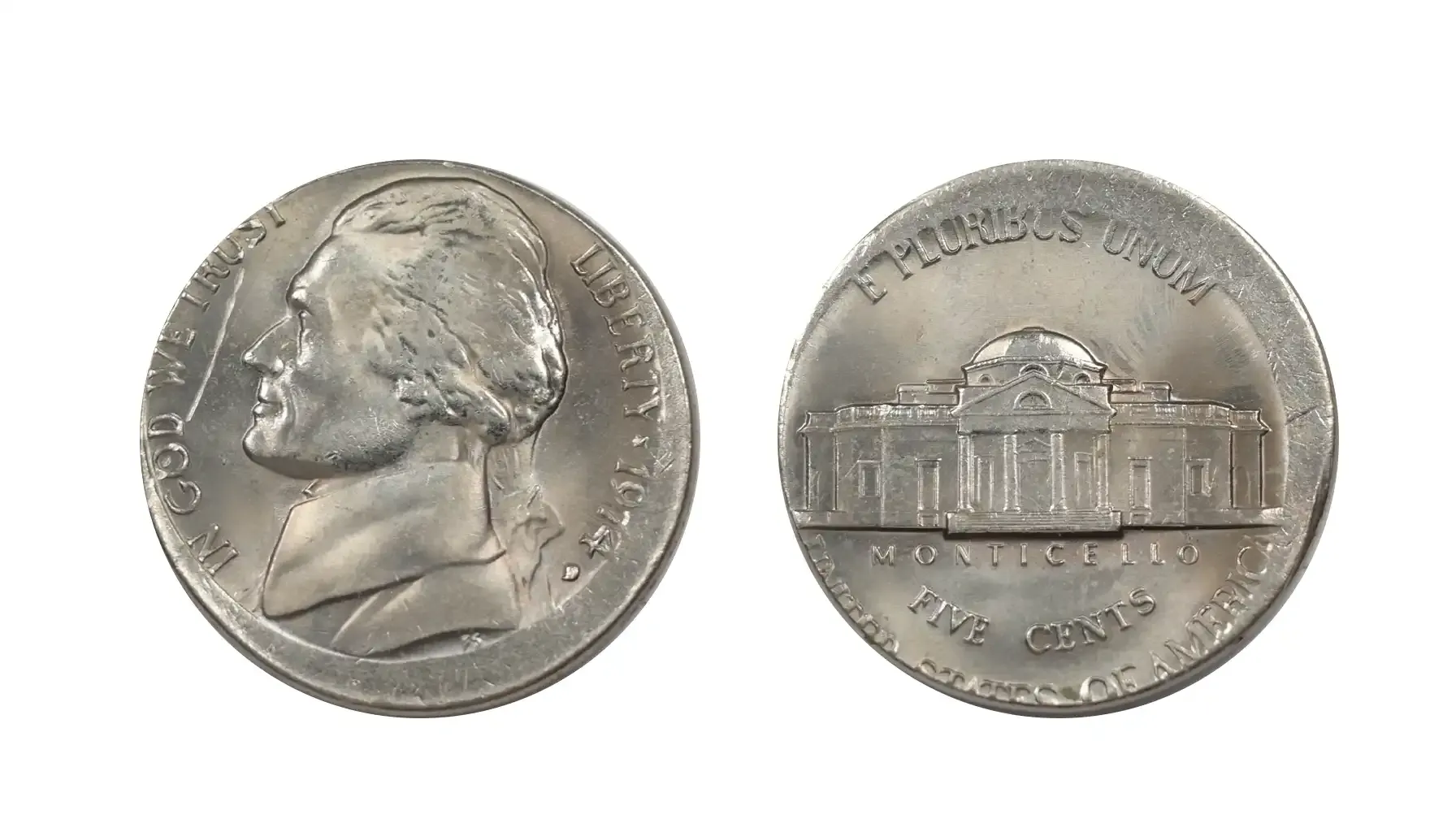
Name | 1944 Jefferson Nickel Off-Center Strike |
Special Features | The coin's design is partially struck off the center of the planchet, leaving a blank area on one side and cutting off the design on the opposite side. |
Mintage | Extremely Low (Accidental anomalies; no official record) |
Price | $20 - $500~ (Value depends on percentage off-center and legibility of date/mint mark) |
Listed prices are approximate and may vary depending on the coin's condition, market demand, and other factors
Market Value
Degree Off-Center & Grade | Price (USD) |
Minor (1-10% off) | $20 - $75 |
Moderate (10-25% off) | $75 - $200 |
Significant (25-50% off, date visible) | $200 - $500~ |
Historical Context
For the 1944 Jefferson Nickels, an off-center strike creates a unique visual anomaly, showcasing a misstep in the production line. The value of these errors is directly proportional to how far off-center the strike is, with those retaining a visible date and mint mark often being the most desirable.
These types of errors contribute to the overall nickel 1944 value for collectors. They are popular among error collectors as clear examples of minting malfunctions, sometimes specifically sought as a 1944-P nickel error value.
1944 Jefferson Nickels Die Break Error
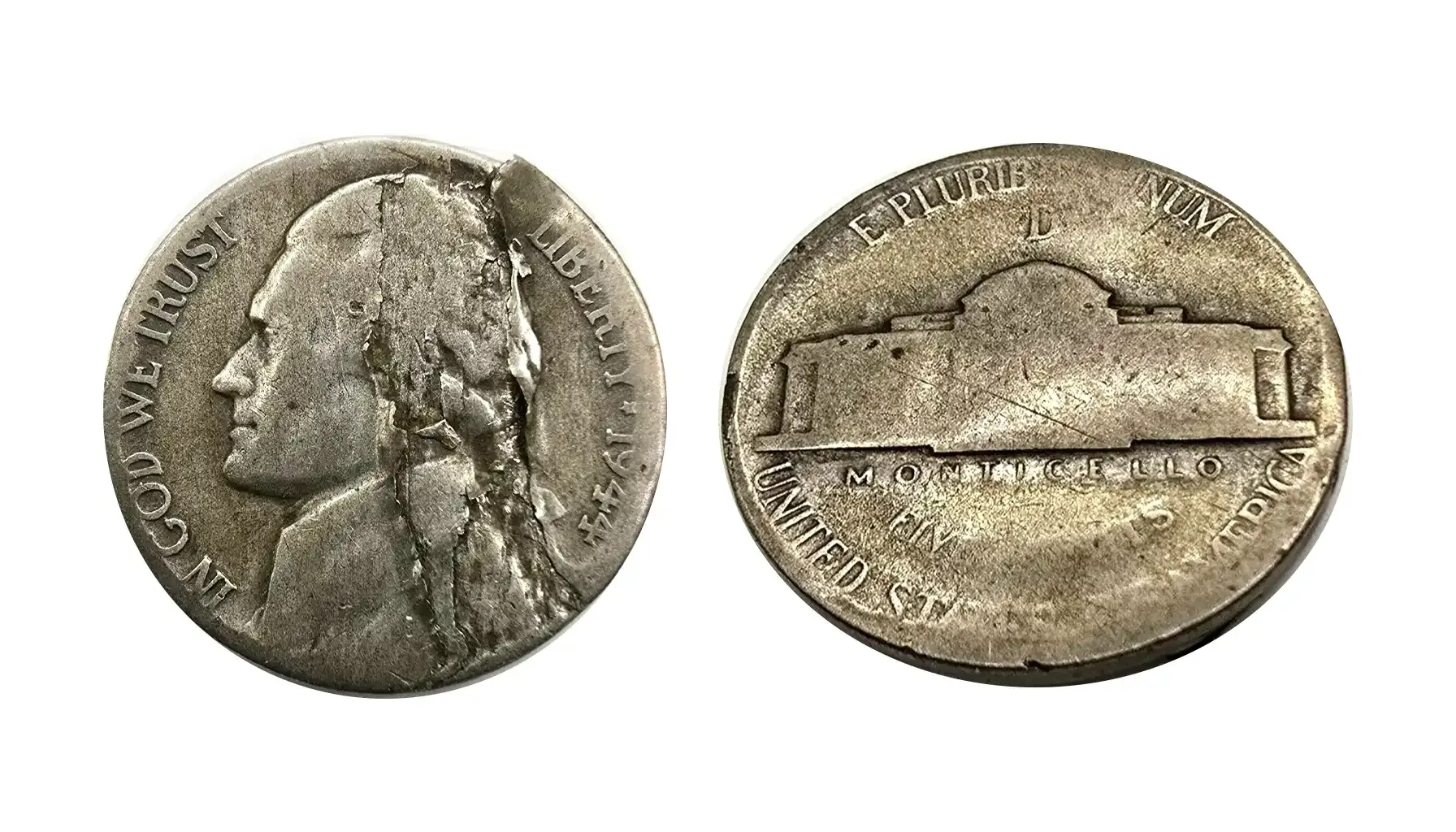
Name | 1944 Jefferson Nickel Die Break |
Special Features | Raised lines (die cracks) or unengraved blobs (cuds, which are larger die breaks) on the coin's surface caused by damage to the coin die. |
Mintage | Extremely Low (Accidental anomalies; no official record) |
Price | $5 - $500~ (Value depends on size, location, and visual impact of the break) |
Listed prices are approximate and may vary depending on the coin's condition, market demand, and other factors
Market Value
Type of Break & Grade | Price (USD) |
Minor Die Crack (Circulated) | $5 - $25 |
Significant Die Crack (Circulated) | $25 - $75 |
Minor Die Break (Uncirculated) | $50 - $150 |
Major Die Break (Cud - Uncirculated) | $150 - $500~ |
Historical Context
Die cracks are hairline fissures that appear on the die, resulting in raised lines on the struck coin. When a piece of the die breaks off entirely, it creates a raised, unengraved blob on the coin known as a "cud." In 1944, with mints operating at high capacity for the war effort, dies were heavily used, increasing the likelihood of such breaks.
These die break errors offer tangible evidence of the strenuous conditions of wartime production and are highly collectible as unique examples of the minting process. A notable 1944-S nickel error related to die breaks, for instance, would be particularly sought after.
In conclusion, the 1944 Jefferson nickel value, including those marked "P", "D", and "S", offer a compelling window into American history during World War II.Understanding the specific mint marks and the unique 1944 nickel silver content of these "War Nickels" is key to appreciating their historical significance and determining their numismatic value. For collectors, the pursuit of these pieces, particularly the scarcer errors or high-grade examples, remains a rewarding journey through the past. The overall 1944 war nickel value can range widely, making every piece a potential treasure.


